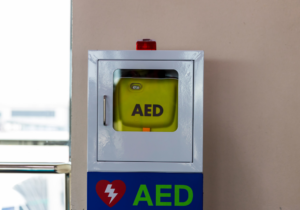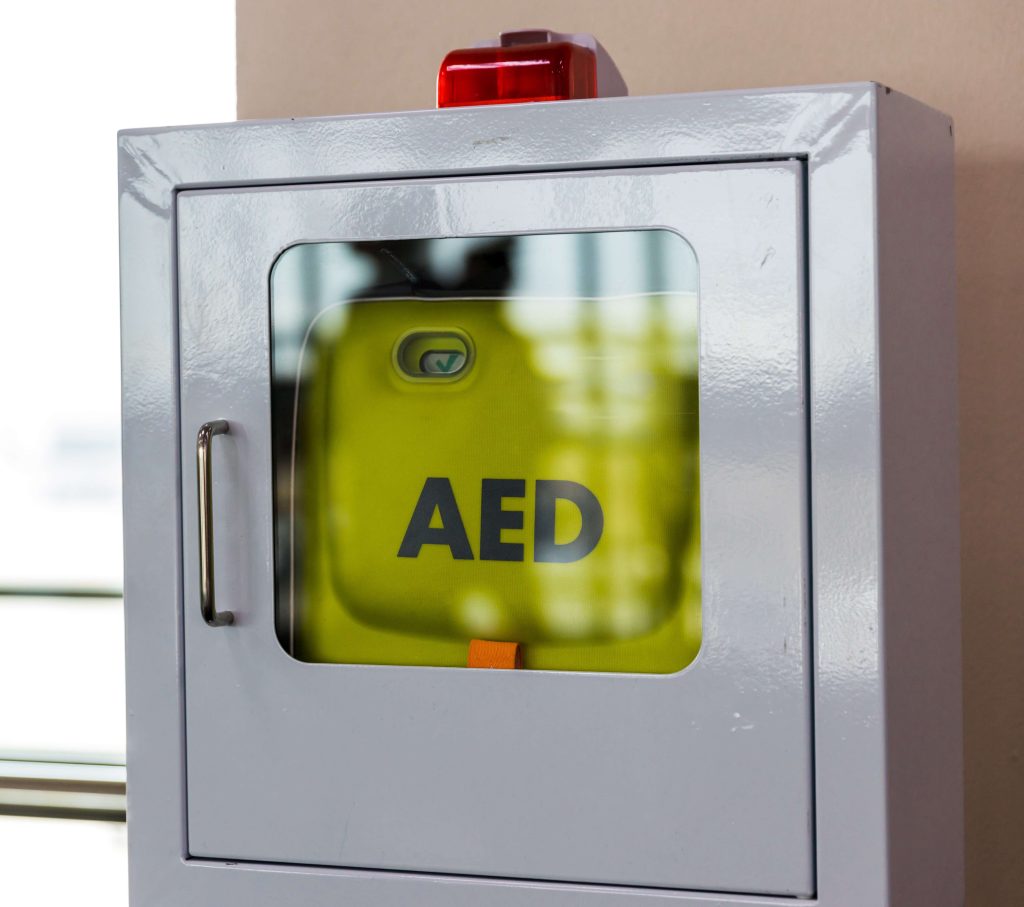Why Mobility Matters for First Aid Instructors
If you teach CPR and first aid outside a fixed classroom, your gear needs to be portable, durable, and ready at a moment’s notice. Travel-based instructors often face limited setup time, smaller spaces, and the need to maintain professional training quality anywhere.
Whether you’re teaching at a workplace, school, or community center, carrying the right CPR equipment ensures that every session runs safely and effectively. Let’s break down the three must-have items that belong in your go-bag.
1) Philips AED — The Portable Lifesaver You Can Rely On
Why a Philips AED Should Always Be in Your Kit
When it comes to automated external defibrillators, Philips AEDs—especially the HeartStart line—are built for reliability and simplicity. Their step-by-step voice guidance and built-in CPR coaching give students (and real responders) confidence during high-stress situations.
Top reasons instructors prefer Philips AEDs:
- Lightweight, compact design perfect for travel.
- Voice prompts guide rescuers through each step of CPR and defibrillation.

- Self-tests automatically verify pad and battery readiness.
- Easy-to-read indicators show when maintenance or replacements are due.
The U.S. Food and Drug Administration (FDA) emphasizes that AED readiness depends on regular maintenance—checking pads, batteries, and performing self-tests to prevent equipment failure when it matters most. AEDs that fail are often linked to expired or degraded components rather than system defects.
???? Maintenance Tip: Before each class, verify the AED’s green “ready” indicator and make sure pads and batteries are within date. Keep spares in your case, stored at room temperature.
The Evidence Behind Early AED Use
Scientific research consistently shows that rapid defibrillation saves lives. When a defibrillator is applied within the first few minutes of cardiac arrest, survival rates rise dramatically.
A recent ScienceDirect study on bystander CPR found that early, high-quality CPR combined with quick AED use significantly improves survival and long-term quality of life after sudden cardiac arrest.
Key takeaway: If you’re teaching CPR or running community training, demonstrating AED use—and ensuring one is always within reach—is vital for public safety education.
2) Compact Feedback Manikin Set — For Realistic, High-Impact Training
Why Feedback Manikins Matter
The heart of every CPR class is hands-on practice. Portable, feedback-enabled manikins allow students to train effectively even in small or temporary classrooms. The best models include compression rate lights and audible clickers that confirm correct depth.
According to the American Heart Association (AHA), quality CPR means:
- Rate: 100–120 compressions per minute
- Depth: About 2 inches (5 cm) for adults
- Full recoil: Let the chest rise between compressions
Manikins with built-in feedback help learners visualize and feel these metrics, leading to stronger retention and more accurate performance in testing and real emergencies.
What to Look For in a Travel Manikin Set:
- Lightweight shells that stack or nest for portability.
- Instant visual feedback for rate and depth.
- Visible chest rise to teach effective ventilations.
- Disposable or easy-swap lungs and valves for hygiene and compliance.
Pro Tip: A 4-pack of manikins allows rotation between learners while maintaining safety standards. Pair this with a metronome app at 110 BPM to reinforce correct rhythm.
3) Hygiene & Airway Essentials — The Overlooked Heroes
What to Include in Your Hygiene Kit
Keeping training equipment clean and safe has become a non-negotiable part of modern instruction. Every mobile trainer should carry a hygiene and airway bundle designed for quick resets between students.
Your kit should include:
- Disposable CPR face shields or one-way valves
- Extra manikin lungs or airways
- EPA-approved disinfectant wipes safe for vinyl surfaces
- Nitrile gloves and small disposal bags
- Hand sanitizer and paper towels
These items let you reset stations in under a minute while maintaining professional hygiene standards.
The FDA and safety organizations stress that proper cleaning and regular part replacement prevent contamination and maintain manikin performance over time.
Quick-Swap Cleaning Routine
Between each student rotation:
- Wipe down the manikin’s face and chest area.
- Replace the lung/valve or add a clean face shield.
- Sanitize the surface and gloves before continuing.
By doing this consistently, you not only protect your students but also extend the lifespan of your gear.
Evidence Snapshot: Why Quality Gear and Technique Matter
Consistent, high-quality CPR and reliable AED access are proven to improve survival after cardiac arrest.
The AHA and multiple clinical studies emphasize that correct compression rate, full recoil, and prompt defibrillation are directly tied to better outcomes. The ScienceDirect study on bystander CPR supports this, showing that bystanders who used AEDs and performed CPR significantly increased victims’ chances of neurologically intact recovery.
These findings reinforce why every instructor—especially those teaching on the go—needs dependable CPR equipment that can handle repeated use and immediate deployment.
Quick Packing Checklist
Copy this into your training planner or equipment bag:
AED (Philips HeartStart or OnSite):
- Device + carry case
- 1 set of pads (in-date)
- Spare pads
- Battery (check expiration)
- Scissors, razor, towel, gloves
Compact Manikin Kit:
- 2 adult torsos + 1 infant
- Spare lungs/valves
- Cleaning wipes
- Feedback monitor or metronome app
Hygiene & Airway Supplies:
- 20 disposable barriers
- 1 pack nitrile gloves
- Sanitizing wipes
- Bio-waste bag
- Hand sanitizer bottle

Where to Buy and Get Help
The fastest way to find authentic CPR and first aid supplies is through a trusted supplier.
Visit CPR Depot USA to browse AEDs, manikins, barriers, and accessories designed for instructors and safety professionals.
Need bulk pricing or shipping help for large training sessions? Their team can help you plan your equipment inventory and replacement cycles — just contact them here.
FAQs
Q1: How often should I replace AED pads and batteries?
Every 2–4 years or before the printed expiration date. Always store spares and check indicators before each class.
Q2: What’s the ideal compression rate and depth to teach?
Follow AHA guidelines: 100–120 compressions per minute at 2 inches (5 cm) deep for adults, with full chest recoil.
Q3: Can I travel with an AED?
Yes. Philips AEDs are FAA-approved for transport, but always check airline regulations before flying.
Q4: How do I clean manikins safely?
Use non-alcohol, surface-safe wipes and replace internal lungs or face shields between users.
Q5: Where can I find trusted CPR equipment online?
Visit CPR Depot USA for verified AEDs, manikins, and accessories shipped across the U.S.

